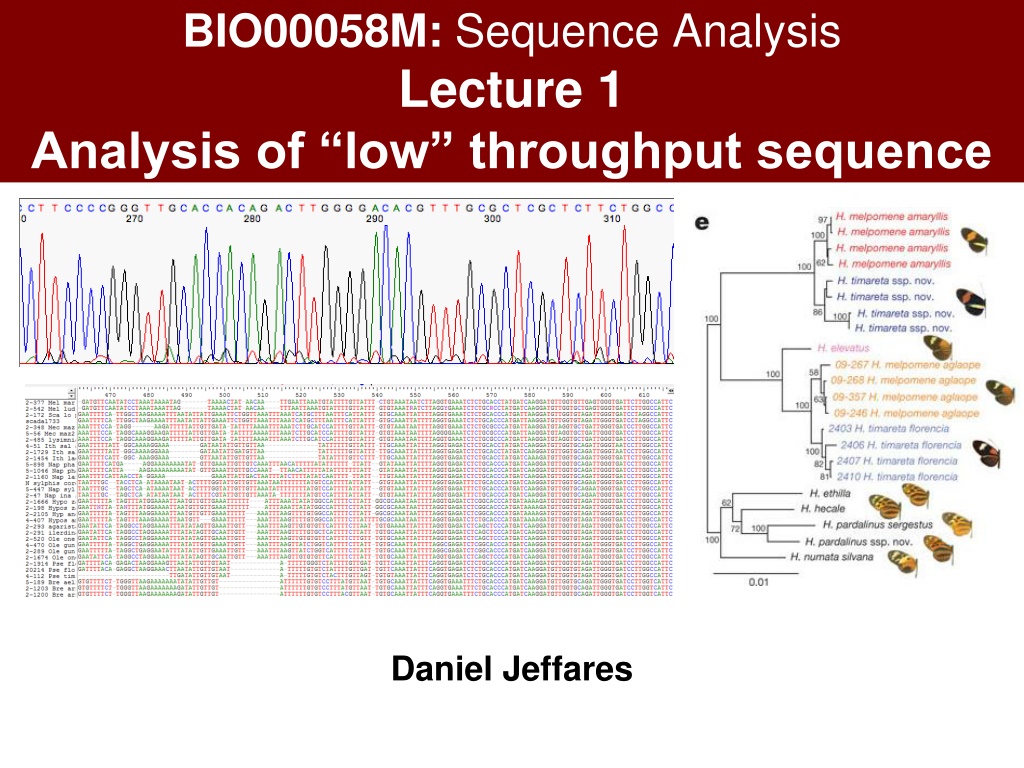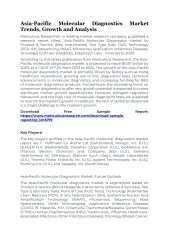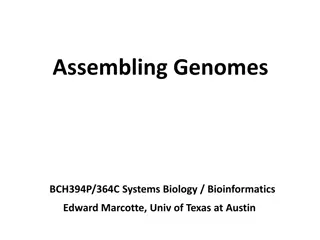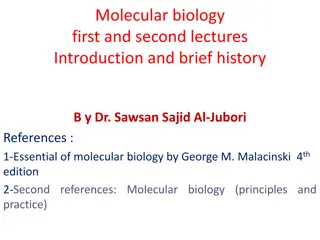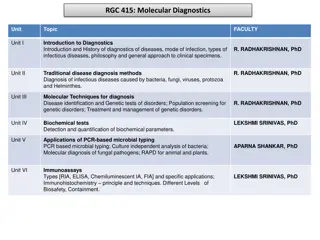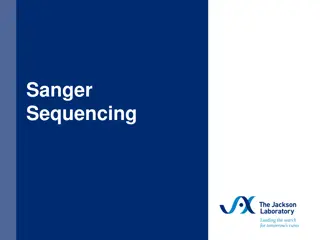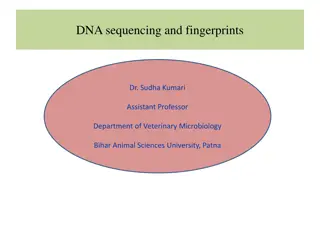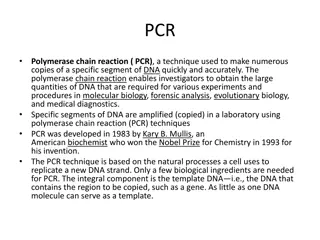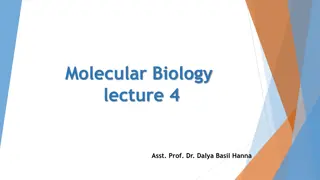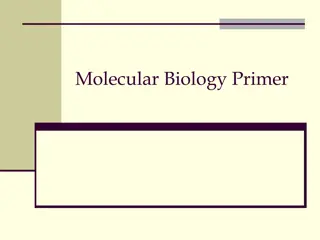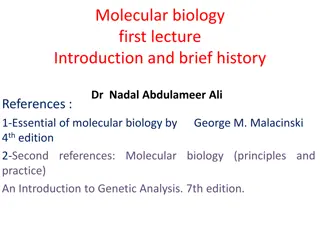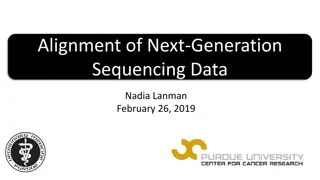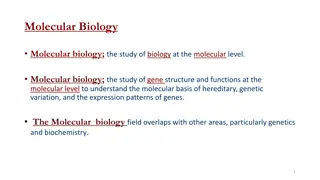Transformative Power of Sequencing in Molecular Biology
The falling costs of sequencing have revolutionized various fields like genetics, genomics, cell biology, microbiology, and evolutionary biology. Sequencing data has enabled us to understand genomes, revolutionize cell biology techniques, conduct comparative genomics, population genomics, and metagenomics studies, and even led to projects like the 100,000 Genome Project. The course covers topics ranging from low throughput sequence analysis to high throughput sequencing and aligning sequences to reference genomes, providing valuable insights into molecular biology and biotechnology.
Download Presentation

Please find below an Image/Link to download the presentation.
The content on the website is provided AS IS for your information and personal use only. It may not be sold, licensed, or shared on other websites without obtaining consent from the author.If you encounter any issues during the download, it is possible that the publisher has removed the file from their server.
You are allowed to download the files provided on this website for personal or commercial use, subject to the condition that they are used lawfully. All files are the property of their respective owners.
The content on the website is provided AS IS for your information and personal use only. It may not be sold, licensed, or shared on other websites without obtaining consent from the author.
E N D
Presentation Transcript
BIO00058M: Sequence Analysis Lecture 1 Analysis of low throughput sequence Daniel Jeffares
Falling cost of sequencing The falling costs of sequencing has transformed genetics, genomics, cell biology, microbiology and evolutionary biology.
Influences of sequence data: Genomes! We can now know the entire gene set of any species. This has an enormous effect on molecular biology, medicine, plant biology, microbiology and biotechnology. Many things we now do routinely were challenging, expensive and/or impossible without genomes. Eg: knocking out (removing a gene). Cell biology has been transformed Many techniques use next generation sequencing (mainly Illumina) to understand cell and organismal function. RNAseq (to examine expression patterns and changes) ChipSeq (to tell us where transcription factors bind) Chromosome conformation capture (3C) (to analyse the spatial organization of chromatin in a cell) Evolutionary biology/molecular ecology has been transformed Comparative genomics: using all the genomes we have, we can now compare entire genomes, and examine what genes have changed over time, and how fast it has changed. Population genomics: by comparing individuals within a species we can locate new events of rapid selection, uncover migrations from the distant past, and do other amazing things like estimate population sizes backwards though time. Metagenomics: allows us to characterise the members of entire ecosystems Even ecosystems within our bodies (human microbiomes)
The 100,000 Genome Project https://www.genomicsengland.co.uk/
What this option is about L1 + W1: Analysis of low throughput sequence data L2 + W2: Introduction to high throughput sequencing. Group projects. L3 + W3: Aligning sequence to reference genomes. SNP calling. L4 + W4: Genome browsers and population genetics L5 + W5: Project plans and help with projects W6: Extra group projects help session LINUX LINUX LINUX LINUX LINUX
L1 + W1: Learning objectives Know how to edit Sanger sequences How to create an alignment How to make phylogenies How to obtain sequences from Genbank
What is a multiple sequence alignment? Conserved region A DNA alignment of the Tpi gene from ithomiine butterflies
Consensus sequence A DNA alignment of the Tpi gene from ithomiine butterflies
Consensus sequence A DNA alignment of the Tpi gene from ithomiine butterflies
What is a multiple sequence alignment? DNA or protein sequences aligned such that positions with same history are aligned with each other A MSA is based on the hypothesis that all sequences are related, i.e., trace back to same common ancestor Sequences that trace back to same common ancestor are homologous* alignment = collection of hypotheses - every column = an hypothesis, i.e., each residue in each sequence traces to same ancestral residue * Homology is an important concept in biology see: https://en.wikipedia.org/wiki/Homology_(biology)
Guidelines for evaluating alignments Modify alignments by eye. You can be better than the computer Minimise indels (insertion/deletion events), especially in coding sequence Experiment with gap penalties For divergent sequences Divide into smaller, similar groups first Find intermediate sequences Accept limitations. If more than one solution, test them all.
Programs for MSA See also: https://en.wikipedia.org/wiki/List_of_sequence_alignment_software#Multiple_sequence_alignment
Phylogenetic tree of lentiviruses Phylogenetic tree of lentiviral integrase core domains Lewis et al (2010) Retrovirology 7:21.
Homologues can be paralogues or orthologues gene X Homologous gene sequences have shared ancestry gene duplication gene X gene X speciation gene X gene X gene X gene X species b species a Globular proteins comprising haemoglobin human haemoglobin subunit gamma2 human haemoglobin subunit gamma1 human haemoglobin subunit epsilon human haemoglobin subunit beta human haemoglobin subunit delta human haemoglobin subunit gamma2 macaque haemoglobin subunit gamma2 macaque haemoglobin subunit gamma1 human haemoglobin subunit gamma1 human haemoglobin subunit epsilon macaque haemoglobin subunit epsilon macaque haemoglobin subunit beta human haemoglobin subunit beta human haemoglobin subunit delta macaque haemoglobin subunit delta
Molecular phylogeny step 1 obtain a good alignment Phylogeny: reconstructing the past based on the present state Only meaningful if comparing things with shared ancestry i.e. homologous sites in homologous sequences Every column in alignment needs to be homologous NEED A GOOD ALIGNMENT Evaluate and clean the alignment Remove regions where homology is uncertain e.g. perhaps regions in and around indels
Distance and discrete phylogenetic methods Distance methods Tree based on pairwise distances between sequences Tree produced by clustering method One solution only Fast, easy and reasonably accurate Methods: UPGMA, neighbour-joining (NJ) Discrete data methods Each position in an alignment considered separately Look for tree that best fits each position in an alignment More detailed and precise. Much slower than distance methods Methods: parsimony, maximum likelihood, Bayesian
Bootstrapping: how good is my tree? How strongly does the data support each branching event? Bootstrapping Create multiple pseudoreplicate datasets from real dataset
Bootstrapping: how good is my tree? Step 1 a) build bootstrap pseudoreplicate datasets Original dataset Bootstrap dataset 2 Bootstrap dataset 1 0123456789 5539282517 1562314951 15 1 seqA ACCGTTCGGT seqB ATGGTTCAGA seqC ATCGATCGGA seqA TTGTGGCTCG seqB TTGAGGGTTA seqC TTCTCGCTTG seqA C seqA seqA CT seqB TT seqB T seqB seqA CTCCGCTTTC seqB TTCGGTTATT seqC TTCCGTAATT seqC TT seqC T seqC b) repeat 1000 times Step 2 build trees for each (= 1000 trees) tree 1 tree 3 tree 2 seqA seqB seqA seqB seqA seqC etc. seqC seqB seqC Step 3 tabulate results seqA seqB 67% seqC NJ tree with bootstrap support
Bootstrapping: how good is my tree? How strongly does the data support each branching event? Bootstrapping Create multiple pseudoreplicate datasets from real dataset Randomly sample each position of an alignment Repeat random sampling with replacement until alignment complete Some positions sampled multiple times, other positions missed out Repeat X times to generate X pseudoreplicate datasets (X > 100) Compute the phylogenetic tree for each pseudoreplicate dataset Calculate what fraction of pseudoreplicate trees support each clade in the original best tree, or on a consensus tree A node may have high bootstrap support, but may be completely wrong Bootstrapping not used for Bayesian trees.
Bootstrapping Bootstrap gives support for a clade, but NOT relationships within the clade in question seqA seqB seqA seqB seqC seqC seqD 92% 92% seqD seqE seqE Theoretically, only bootstraps > 95% are significant Experimental evidence: bootstraps > 70% show strong clade support for molecular data (Hillis & Bull 1993. Systematic Biology 42: 182-192) what if BP > 90% for clade of interest, but <50% for others? Tree does not have to be fully resolved to be useful
Displaying phylogenetic trees Think who is going to be looking at the figure, and what will help them see what is important Use real names and not accession numbers Place bootstrap percentage on branch leading to the relevant clade Scale bar and what it stands for Use colours and pictures to clarify and draw attention to interesting parts of the tree Figure + legend should be stand-alone Figure title: short and succinct and informative Figure legend: Describe what the tree is (gene, phylogenetic method, taxa) Number of bootstrap replicates
Phylogeny programs Distance methods MEGA: user friendly Likelihood MrBayes: Bayesian inference BEAST: more for population analyses PHYML: fast maximum likelihood RAxML: better maximum likelihood PHYLIP: NJ, parsimony, likelihood PAUP: NJ, parsimony, likelihood
Further information Page & Holmes (1998) Molecular evolution: a phylogenetic approach. Blackwell Science Felsenstein (2004) Inferring phylogenies. Sinauer Associates Wikipedia + manuals for software Barry G. Hall (2004) Phylogenetic Trees Made Easy (book). Sinauer Associates.
Linux Servers running the Linux operating system are used for bioinformatics analyses Why? Large datasets Large RAM requirements Stable and more secure operating system
Linux Tutorial You will be using linux command line machines for your workshops and projects. This will be challenging unless you have a basic knowledge of linux commands. So, learn about it before you get into the computer lab. Before workshop 2: Do this Linux tutorial: https://www.york.ac.uk/res/dasmahapatra/teaching/MBiol_sequence_anal ysis/intro_to_linux_2019.html Further linux help: https://www.york.ac.uk/res/dasmahapatra/teaching/MBiol_sequence_anal ysis/ sequence_analysis_index.html
equence analysis forum item options ide Details Confused? Here s what to do 1. 2. First, check the workshop manuals. Then use google: bioinformatics problems/solutions are very well documented on the internet (bioinformatics geeks love the internet) Then, use the discussion board on the VLE: (called the sequence analysis forum). a) Feel free to reply to comments to help each other out. b) Teaching staff will reply to questions posted here but NOT 24/7, so please be patient with replies. Then, email/come and see me: kanchon.dasmahapatra@york.ac.uk 3. 4.
Workshop 1 In workshop 1 (tomorrow) we will learning how to use Sanger low throughput sequence files. We will be making alignments and trees.
